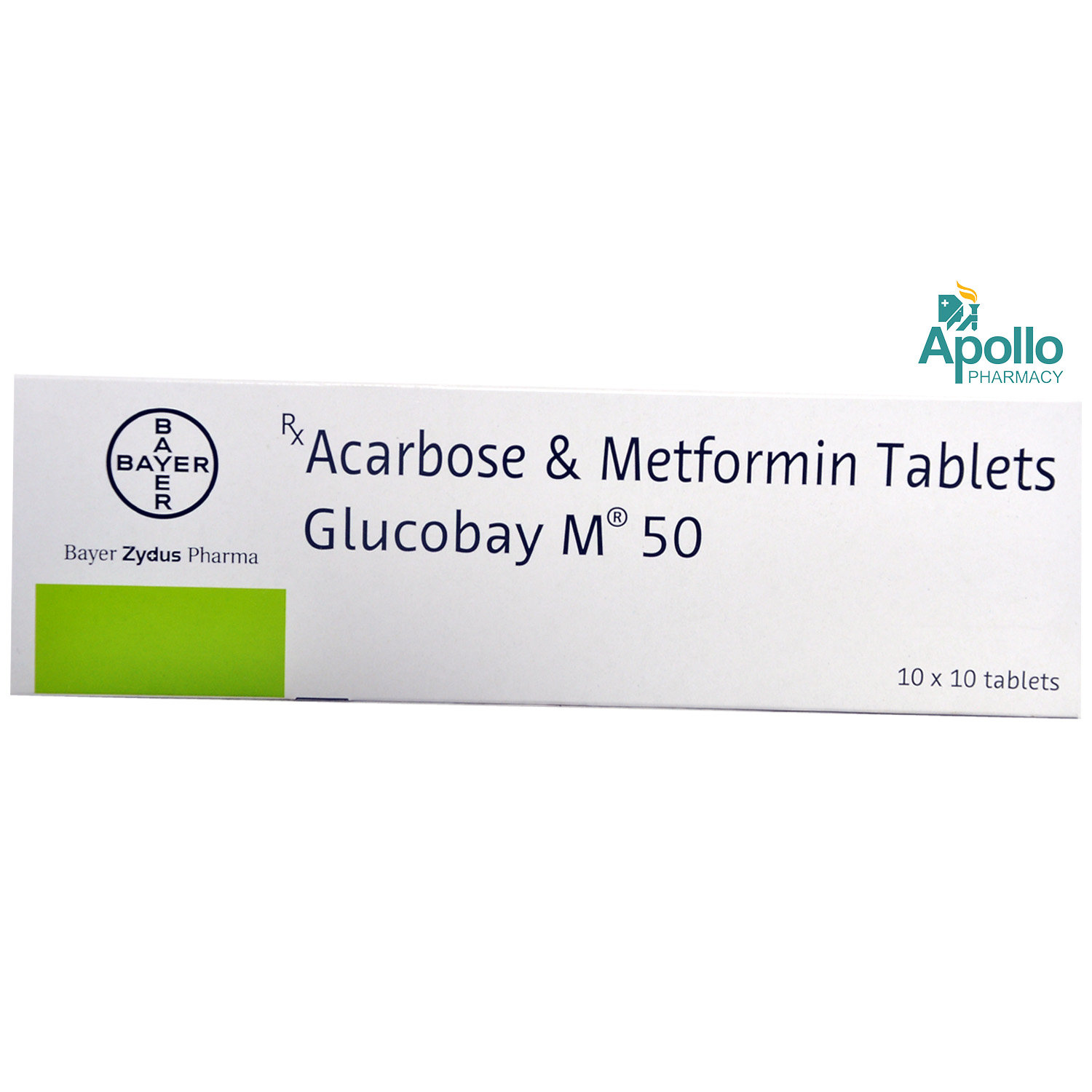G Bay M 50 mg/500 mg Tablet

MRP ₹140.5
(Inclusive of all Taxes)
₹21.1 Cashback (15%)
know your delivery time
Provide Delivery Location
Composition :
Manufacturer/Marketer :
Consume Type :
Expires on or after :
Return Policy :

Secure Payment

Trusted by 8 Crore Indians

Genuine Products
Therapeutic Class
Country of origin
Manufacturer/Marketer address
Disclaimer
Alcohol
Safe if prescribed
You are should avoid consuming alcohol with G Bay M 50 mg/500 mg Tablet as it may lead to high or low blood sugar levels.
Pregnancy
Consult your doctor
G Bay M 50 mg/500 mg Tablet is a Category B pregnancy drug that is not recommended for pregnant women or given only when strictly guidance of the doctor as there is no clinical data available on use in pregnant women.
Breast Feeding
Consult your doctor
Avoid nursing your baby while taking G Bay M 50 mg/500 mg Tablet as this medicine may pass in breast milk.
Driving
Safe if prescribed
G Bay M 50 mg/500 mg Tablet is safe to take before driving as it does not affect your thinking ability.
Liver
Consult your doctor
Take G Bay M 50 mg/500 mg Tablet only after the doctor's prescription, especially if you are dealing with Liver diseases/conditions as your doctor may adjust the dose as required.
Kidney
Consult your doctor
Take G Bay M 50 mg/500 mg Tablet after the recommendation of a doctor, especially if you have a history of Kidney diseases/conditions. The dosing strength needs to be adjusted by your doctor as required.
Children
Safe if prescribed
The use of G Bay M 50 mg/500 mg Tablet is unsafe for children below 12 years.
Product Substitutes
About G Bay M 50 mg/500 mg Tablet
G Bay M 50 mg/500 mg Tablet belongs to the category of medicines called 'anti-diabetic' primarily used for the management and treatment of type 2 diabetes, especially in persons whose sugar levels are too high and cannot be only controlled by dieting and exercising. Type 2 diabetes is a condition which occurs when there is either less insulin or available insulin is not properly utilized by our body cells for lowering raised blood glucose. It is the most common type of diabetes accounting for around 90% of total diabetes cases found commonly in middle-aged people. So it is also called as adult-onset diabetes or non-insulin dependent diabetes mellitus (NIDDM).
G Bay M 50 mg/500 mg Tablet contains two medicines namely: 'Metformin' and 'Acarbose'. Metformin is a 'biguanides' that works by reducing the amount of blood sugar released in the blood stream by the liver thereby making body respond in a better way to insulin. On the other hand, 'Acarbose; is an ‘alpha glucosidase inhibitor’ which works by slowing down the action of intestinal enzymes responsible for the digestion of complex sugars/glucose thereby slowing and reducing the absorption of sugar into the blood after every meal.
Take G Bay M 50 mg/500 mg Tablet as prescribed. Your doctor will recommend you how often you take G Bay M 50 mg/500 mg Tablet based on your medical condition. Some people may experience some unpleasant effects in the beginning of the treatment with G Bay M 50 mg/500 mg Tablet such as increased wind, rumbling in your stomach and abdominal cramps which happen as the body is adjusting to the new medicine. However, if these unpleasant effects continue for more than days or become severe or experience diarrhoea, then seek medical attention immediately.
If you are hypersensitive to any of the components present in these medicines, then please tell your doctor before taking this drug. G Bay M 50 mg/500 mg Tablet is not allowed to use in children. If you are pregnant or breastfeeding or planning to be pregnant, then tell your doctor before they prescribe this medicine to you. Limit your alcohol consumption with G Bay M 50 mg/500 mg Tablet as alcohol may cause a rapid increase or decrease in blood sugar levels.
Uses of G Bay M 50 mg/500 mg Tablet
Medicinal Benefits Mweb
Key Benefits
G Bay M 50 mg/500 mg Tablet is an anti-diabetic drug, indicated in the treatment of type 2 diabetes or non-insulin-dependent diabetes (NIDDM). This medicine is primarily prescribed to persons whose blood sugar levels are high and is even not controlled by diet and exercise alone. G Bay M 50 mg/500 mg Tablet consists of Acarbose and Metformin, used for controlling raised blood sugar in type 2 diabetes patients. Acarbose is an ‘alpha-glucosidase inhibitor’ responsible for the inhibition of intestinal enzymes that delays the digestion of carbohydrates taken through the meal. Metformin belongs to a group of medications called 'biguanides' that works by improving glucose tolerance in patients dealing with type 2 diabetes. It also reduces the intestinal absorption of glucose, and thus increases the utilization of glucose. Together it avoids the additional risk of disease associated with diabetes such as eye problems (diabetes retinopathy), kidney damage (diabetic nephropathy), nerve damage (diabetic neuropathy), diabetic foot ulcer, delayed wound healing and other diabetic complications.
Directions for Use
Side Effects of G Bay M 50 mg/500 mg Tablet
- Flatulence (gas)
- Abdominal discomfort
- Stomach pain
- Diarrhea
Drug Warnings
Tell your doctor if you have kidney disease, high ketone levels in blood or urine, heart disease, congestive heart failure, liver disease or you are using insulin, or other oral diabetes medications. A person should keep taking G Bay M 50 mg/500 mg Tablet even if they are feeling that their blood sugar levels are under control as it may again spike the level of sugar in the blood. Try to take a dose at the right time so that you did not forget to take a dose, ask your doctor for advice. It may be possible that a person may develop lactic acidosis, which happens due to the overproduction of lactic acid in the blood so tell your doctor if you are noticing any symptoms of it. You should take small frequent meals and don't fast while being treated with G Bay M 50 mg/500 mg Tablet . Try to notice if you are developing the symptoms of hypoglycemia (low blood sugar) like sweating, dizziness, dry mouth, dry skin, palpitations, shivering, intense thirst, frequent urination, etc. If you notice any of the mentioned symptoms, then immediately take 5-6 candies or honey/sugar and consult with a physician.
Drug-Drug Interactions Checker List
- METFORMIN
- DIGOXIN
- NEOMYCIN
- CHOLESTYRAMINE
- LIPASE
- AMYLASE+PAPAIN
- CHARCOAL
- PANCREATIN
Habit Forming
Special Advise
You should have Glycated hemoglobin (HbA1C) test every 3 months to check your blood glucose level control.
Diet & Lifestyle Advise
- A person should engage themself in regular exercise like cycling, running, walking, jogging, dancing, or swimming for at least 30 minutes. Try to invest at least 150 minutes weekly in exercise.
- A person should also maintain healthy body weight to avoid obesity or high blood sugar it can increase the risk of the onset of diabetes.
- A person should take low fat and a low sugar diet. For that replace carbohydrates with whole grains, fruits, and vegetables as carbohydrates changed into sugars leading to high blood sugar levels.
- Try to avoid potatoes as they are high glycemic foods that increase the risk of high sugar in the blood.
- A person should limit the consumption of alcohol and quit smoking.
All Substitutes & Brand Comparisons
RX
Out of StockAcobose M 50mg/500mg Tablet
₹161
(₹14.49 per unit)
14% COSTLIERRX
Glubreak M 50/500 Tablet 10's
N Line Healthcare Pvt Ltd
₹154.5
(₹15.45 per unit)
22% COSTLIERRX
Out of StockPeribite M 50 Tablet 10's
Spectra Therapeutics Pvt Ltd
₹154.5
(₹15.45 per unit)
22% COSTLIER

Have a query?
Buy best Diabetics products by
Torrent Pharmaceuticals Ltd
Sun Pharmaceutical Industries Ltd
Eris Life Sciences Ltd
Intas Pharmaceuticals Ltd
Lupin Ltd
Micro Labs Ltd
Mankind Pharma Pvt Ltd
Lloyd Healthcare Pvt Ltd
Alkem Laboratories Ltd
Abbott India Ltd
Glenmark Pharmaceuticals Ltd
Cipla Ltd
Macleods Pharmaceuticals Ltd
Wockhardt Ltd
Dr Reddy's Laboratories Ltd
Primus Remedies Pvt Ltd
USV Pvt Ltd
Aristo Pharmaceuticals Pvt Ltd
Emcure Pharmaceuticals Ltd
Alembic Pharmaceuticals Ltd
Ipca Laboratories Ltd
La Renon Healthcare Pvt Ltd
Ajanta Pharma Ltd
Medley Pharmaceuticals Ltd
East West Pharma India Pvt Ltd
Elbrit Life Sciences Pvt Ltd
Corona Remedies Pvt Ltd
Hbc Life Sciences Pvt Ltd
Sinsan Pharmaceuticals Pvt Ltd
Ranmarc Labs
Mitoch Pharma Pvt Ltd
Zydus Healthcare Ltd
Sanofi India Ltd
Akumentis Healthcare Ltd
Fusion Health Care Pvt Ltd
Unison Pharmaceuticals Pvt Ltd
Jubilant Lifesciences Ltd
Novo Nordisk India Pvt Ltd
Tas Med India Pvt Ltd
Blue Cross Laboratories Pvt Ltd
Msn Laboratories Pvt Ltd
Eswar Therapeutics Pvt Ltd
Indoco Remedies Ltd
Q Check Pharmaceuticals
Alteus Biogenics Pvt Ltd
Anthem Bio Pharma
Franco Indian Pharmaceuticals Pvt Ltd
Systopic Laboratories Pvt Ltd
Panacea Biotec Ltd
Zydus Cadila
Biocon Ltd
Edoc Life Sciences Pvt Ltd
Koye Pharmaceuticals Pvt Ltd
Arkas Pharma Pvt Ltd
Diacardus Pharmacy Pvt Ltd
Elinor Pharmaceuticals (P) Ltd
Remedy Life Sciences Pvt Ltd
Saan Labs
Talent India Pvt Ltd
Jarun Pharmaceuticals Pvt Ltd
Capital Pharma
Shrrishti Health Care Products Pvt Ltd
FDC Ltd
Leeford Healthcare Ltd
Nirvana India Pvt Ltd
Elder Pharmaceuticals Ltd
Eli Lilly and Company (India) Pvt Ltd
Glynis Pharmaceuticals Pvt Ltd
Zuventus Healthcare Ltd
Arrient Healthcare Pvt Ltd
Cadomed Pharmaceuticals India Pvt Ltd
Orris Pharmaceuticals
Akesiss Pharma Pvt Ltd
Bal Pharma Ltd
Biochem Pharmaceutical Industries Ltd
Knoll Healthcare Pvt Ltd
Lippon Pharma Pvt Ltd
Morepen Laboratories Ltd
Neucure Lifesciences Pvt Ltd
Opsis Care Lifesciences Pvt Ltd
Wallace Pharmaceuticals Pvt Ltd
Acmedix Pharma Llp
Converge Biotech Pvt Ltd
Erinyle Pharma
Indiabulls Pharmaceuticals Pvt Ltd
Ozone Pharmaceuticals Ltd
Retra Life Science Pvt Ltd
Alvio Pharmaceuticals Pvt Ltd
Geneaid Pharmaceuticals
Heal (India) Laboratories Pvt Ltd
Olcare Laboratories Pvt Ltd
Vasu Organics Pvt Ltd
Kotak Life Sciences
Lakshya Life Sciences Pvt Ltd
Proqol Health Care Pvt Ltd
Sanz Pharmaceuticals
Daylon healthcare pvt Ltd
Mcronus Lifescience Pvt Ltd
Natco Pharma Ltd
Orsim Pharma
Customers Also Bought





